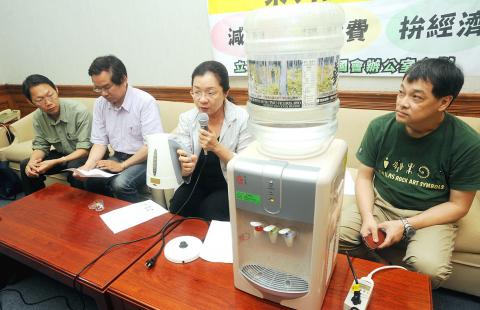The public should avoid using hot-and-cold-water dispensers, to save electricity and improve the quality of drinking water, Democratic Progressive Party Legislator Tien Chiu-chin (田秋堇) and environmentalists said yesterday.
Holding a report by the National Science Council on the results of its National Science and Technology Program on Energy, Tien said the report showed that there are about 5.48 million water dispensers in use nationwide, consuming about 3.147 billion kilowatt hours (kWh) of electricity each year.
The number is equal to about 6.79 percent of the residential and commercial sectors’ total annual electricity consumption and is also equal to about one-third of the electricity supplied annually by a nuclear reactor, she added.

Photo: Lin Cheng-kung, Taipei Times
Green Consumers’ Foundation chairman Jay Fang (方儉) said water dispensers consume a lot of electricity because they have to continuously provide both boiling hot and cold water, and according to the foundations experiment, a water dispenser consumes about 1.6 kWh of electricity per day.
In contrast, electric kettles use a large amount of electricity only for the few minutes while they heat the water, but can keep the water warm for a long period of time without consuming electricity. This is safer and saves energy by only using about 0.09 kWh to boil a liter of water, Fang said.
“In addition, water that is repeatedly boiled in water dispensers may cause the accumulation of harmful substances, such as heavy metals,” he said.
Fang added that it is difficult to clean a water dispenser’s pipes and water container, so the water quality may be worse than the quality of water from kettles, which can be washed easily after use.
“Most Taiwanese are taught the importance of increasing income and reducing expenditure as they grow up. However, the government is stubbornly trying to only increase the supply of electricity, which will never meet the fast-growing demand if reducing power consumption is not considered,” Nuclear-Free Homeland Alliance executive director Lee Cho-han (李卓翰) said.
Green Party Taiwan member Pan Han-shen (潘翰聲) said when Germany evaluated the scenario of supplying 100 percent of its electricity needs from renewable sources by 2050, it assumed a reduction in final energy consumption of 58 percent in the household, industrial, trade, commerce and services sectors.

Taiwanese scientists have engineered plants that can capture about 50 percent more carbon dioxide and produce more than twice as many seeds as unmodified plants, a breakthrough they hope could one day help mitigate global warming and grow more food staples such as rice. If applied to major food crops, the new system could cut carbon emissions and raise yields “without additional equipment or labor costs,” Academia Sinica researcher and lead author the study Lu Kuan-jen (呂冠箴) said. Academia Sinica president James Liao (廖俊智) said that as humans emit 9.6 billion tonnes of carbon dioxide compared with the 220 billion tonnes absorbed

The Taipei Mass Rapid Transit (MRT) Wanda-Zhonghe Line is 81.7 percent complete, with public opening targeted for the end of 2027, New Taipei City Mayor Hou You-yi (侯友宜) said today. Surrounding roads are to be open to the public by the end of next year, Hou said during an inspection of construction progress. The 9.5km line, featuring nine underground stations and one depot, is expected to connect Chiang Kai-shek Memorial Hall Station to Chukuang Station in New Taipei City’s Jhonghe District (中和). All 18 tunnels for the line are complete, while the main structures of the stations and depot are mostly finished, he

Taipei is to implement widespread road closures around Taipei 101 on Friday to make way for large crowds during the Double Ten National Day celebration, the Taipei Department of Transportation said. A four-minute fireworks display is to be launched from the skyscraper, along with a performance by 500 drones flying in formation above the nearby Nanshan A21 site, starting at 10pm. Vehicle restrictions would occur in phases, they said. From 5pm to 9pm, inner lanes of Songshou Road between Taipei City Hall and Taipei 101 are to be closed, with only the outer lanes remaining open. Between 9pm and 9:40pm, the section is

China’s plan to deploy a new hypersonic ballistic missile at a Chinese People’s Liberation Army Rocket Force (PLARF) base near Taiwan likely targets US airbases and ships in the western Pacific, but it would also present new threats to Taiwan, defense experts said. The New York Times — citing a US Department of Defense report from last year on China’s military power — on Monday reported in an article titled “The missiles threatening Taiwan” that China has stockpiled 3,500 missiles, 1.5 times more than four years earlier. Although it is unclear how many of those missiles were targeting Taiwan, the newspaper reported